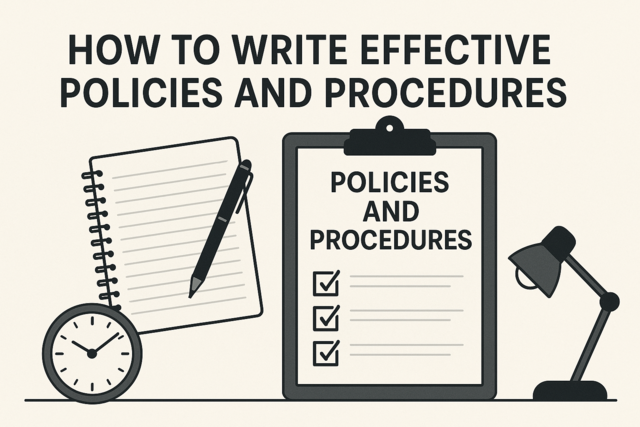Putting aside aspects of unlawfulness and lawfulness, some terminations are necessary and there's little excuse for an employer to not go through with their intentions to fire an employee. It's inevitable, and fighting to stop the event from happening only makes things worse-think in cases where the employee is doing serious harm towards the business, their peers, and themselves. The reasoning will be undoubtedly legitimate and thus there's no concerns about unlawful employee termination occurring based on those grounds. What about when the decision's already been made? What can you do then to ensure that the execution of the termination itself remains as lawful as the rest of the process?
This article will look at the usage by employers of a termination checklist and what value it provides towards ensuring the legality of a termination. Topics will include the reasoning behind using a checklist and, in order, the different components needed for the list to comprehensive. As an employer, you may need to add additional steps in the checklist you use based on aspects of your business, with this list as the basis for the required steps. For employees, this list is a reference of what needs to be done before you leave the business for good and can be your way of ensuring that you don't leave any loose ends.
Why Should You Do This?
Once the decision to terminate has been finalized, it's often best to deliver the termination through a termination meeting. This is the formal sit-down with the employee to inform them that they've been fired and explain what will happen as a result. The events of that meeting are usually what is covered under a termination checklist, but the list often starts off with preparations for the meeting. This means putting together any documentation that will be presented to the employee and finalizing the details of their termination. Anything that needs to be done for recordkeeping purposes should be done in advance of the meeting, if possible, to make sure that everything is set. You will want to collect some basic data-name, job title, termination reason, supervisor, etc.-to be used during the meeting and for reference with the rest of the checklist.2
Notifications
There are several people that need to be notified of the termination in addition to the employee themselves. This can include people like their direct supervisor or manager and anyone who may need to be present for the termination. If the employee being terminated is a part of a union, then you may want to contact a representative from their union and/or give the employee the option to have a representative accompany them to the meeting.
� Human Resources-It's standard for HR to be involved in any employee-related events, simply because it's a part of their job. They are to be notified well in advance of when the termination will be made as they often have work to do on their end. A representative from HR is usually present at a termination meeting and department staff will usually handle all of the formal paperwork tied to ending employment. If necessary, you may want to have them be the first ones notified when the decision to terminate is first presented as an option and keep them informed throughout the termination process.
� Legal Department-For posterity's sake, legal may need to be notified of a termination so they can verify the legalities of the situation. They may need to check any documents or agreements that the employee will need to sign, and will likely be the ones to oversee and provide any legal forms for the situation. Like with HR, a representative from the department may attend the termination meeting.
� Official Notice to Employee-No law states that advanced notice is required for employment termination, but it's still an ethically sound and professional thing to do.3 An official notice to the employee could be sent to inform them of the meeting and their termination itself. It's a curtesy that allows them to prepare on their own and to avoid any shock that the situation might cause. Some employers include a request for a resignation letter along with the notice, for the sake of formality and acknowledgement of the end of their employment with the company.4
Permissions And Access
Any access and permissions that a terminated employee has as a part of their employment need to be severed. This means collecting things like their keys and deactivating their company accounts. It ensures the finality of the situation and prevents them from using aspects of their employee access to retaliate.
� Network Access-Contact IT and instruct them to remove the employee from the company's digital network, including their password and login information.5 Have IT log them out of the system entirely, including any remote access (e.g. access at home, mobile usage), to ensure that there isn't a backdoor left for them to get it. It's best to wait until the termination meeting itself to do this, as they may need access to complete any final work before they leave.
� How Do Employees Access Company Property?-Keys, key cards, and PIN codes that employees use to access different areas of the business's physical property should also be confiscated. PINs can be remotely removed by IT without having to change the system entirely or inconvenience other employees. These items can be collected during the meeting or directly after-do not let them hang on to them.
Returning Property
Anything that either party has in their possession that isn't there should be returned at the termination meeting or at its close. Company issued property like ID badges, keys, equipment (e.g. laptops, tablets, etc.), and other items provided to the employee as a part of their job should be relinquished without question.6 Certain items may need to be handled carefully to avoid unnecessary inconveniences; additional arrangements for things like a company car that the employee uses to get to and from work would have to be made.
� Offices, Lockers, and Desks-Employees should be given time to collect their personal items upon being terminated. This may be done directly after the meeting or at a later time; if they have an office, for example, they may need several hours to thoroughly clear out. Do not allow them to do this on their own, as some employees may use this time for retaliation. Have someone supervise them (e.g. security) and escort them out when they're done.
Benefits Status
Despite being terminated, employees often are still entitled to certain benefits as a part of their legal rights.7 These are things that may be tied to their pay or time worked, and may be included as part of a severance package. Some benefits, like insurance plans, are not going to be permanent things that the employee has but will come with a grace period for their remaining use (e.g. until the end of the contract year). They will also be able to receive benefits like unemployment or COBRA (the Consolidated Omnibus Budget Reconciliation Act), which provides terminated employees from businesses with 20 employees or more 18 months access to health care.8
� Unused Time Off?-Terminated employees are entitled to any paid leave time, including sick days. If they have any unused paid time off, that will be included in their benefits.9 Of course, if they do not have any unused time left then it isn't an issue; consider providing formal notice just in case to avoid conflict.
� Status Letter-HR should provide the employee with a letter that details what benefits they will receive and any pertinent information about those benefits. This should outline things such as what the benefit is, how long they will have it post-termination, and any other conditions associated.10 It will be treated as a legally binding document of what they are owed, so it should be error-free and precise in regards to the information it provides.
Payments Due
Terminated employees are entitled to any earnings they have for their hours worked. This should be calculated as precisely as possible, including any time worked on the day of their termination to ensure that they are getting all of what they are legally due.11 Some employers choose to have payroll round upwards to the next full hour for final pay-e.g. if they worked from 6:00AM to 11:30AM before they were terminated, award them pay earned through to 12:00PM. The employee should be notified of when they will receive their final pay and what arrangements may be needed to collect it.
Paperwork
The termination meeting is also the time to tackle any paperwork that the employee must fill out before leaving the company for good. These are often crucial for legal and logistics reasons, so their inclusion on this checklist is necessary and must not be forgotten. The documents can include things like waivers and agreements regarding aspects of their termination (e.g. benefits). Often, these documents will be prepared and presented by the legal and/or HR departments, hence why their notification earlier in the checklist is so important.
� Non-Compete Agreements-Legal documents like non-compete agreements are designed to protect the business' information and intellectual assets from being disclosed to their industry and market competitors.12 The agreement usually lays out any conditions regarding what the employee can do in the same industry or with similar companies in regards to work. While this may seem like a one-sided benefit for the employer, it can help prevent the employee from being used by competing businesses and from being put in a legal bind. This should be done if the employee had not already signed such an agreement upon being hired, or if past agreements are no longer valid.
� Non-Disclosure Agreements-A NDA or confidentiality agreement can also keep company secrets from being leaked into the public or shared with competitors. It can also be used to prevent the disclosure of personal information and to stop the employee from slandering the company or their employer in retaliation for being terminated.
� Permission for References-Even if the employee has some really hard feelings about being terminated, it's unlikely that they will not include their time with the company on future job applications and resumes. In the event that a future employer for the employee contacts the company as a reference of previous employment, you may want the employee to sign a permission form to disclose information about their time there. This will allow you to disclose things such as the details of the termination or other relevant information that may not be formally included as a part of a reference or background check.
Exit Interview
Conducting an exit interview is usually standard when an employee quits or retires, but it can still be done in the event of a termination. These can be valuable sources of information and feedback for both the employee and the employer, and may even provide a sense of closure on this chapter of the employee's career.13 There's a little less formality in an exit interview, so employees feel more comfortable being candid in their responses-which means you might get a more honest answer than you would during their employment. Ask questions about things like their working conditions, duties and responsibilities, training, or even their experience in the termination process itself. Let them ask questions of you and don't be surprised if their feelings about their termination present themselves during the interview.
























